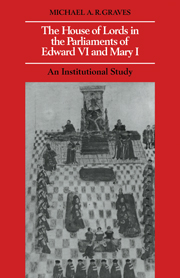Book contents
- Frontmatter
- Contents
- Dedication
- Preface
- Parliamentary sessions, 1547–8
- 1 Introduction
- 2 The composition of the House
- 3 The quality of the House
- 4 Attendance and activity, absenteeism and management
- 5 Cohesion and division
- 6 The Lords' inheritance: clerks and assistants to the House
- 7 The rules of business: procedure
- 8 The legislative record of the mid-Tudor Lords
- Abbreviations
- Appendix A Composition
- Appendix B Roll of the ‘actual’ members of the House of Lords, 1547–58
- Appendix C Attendance
- Appendix D Legislation
- Notes
- Select bibliography
- Index
2 - The composition of the House
Published online by Cambridge University Press: 03 May 2010
- Frontmatter
- Contents
- Dedication
- Preface
- Parliamentary sessions, 1547–8
- 1 Introduction
- 2 The composition of the House
- 3 The quality of the House
- 4 Attendance and activity, absenteeism and management
- 5 Cohesion and division
- 6 The Lords' inheritance: clerks and assistants to the House
- 7 The rules of business: procedure
- 8 The legislative record of the mid-Tudor Lords
- Abbreviations
- Appendix A Composition
- Appendix B Roll of the ‘actual’ members of the House of Lords, 1547–58
- Appendix C Attendance
- Appendix D Legislation
- Notes
- Select bibliography
- Index
Summary
Membership of the mid-Tudor Upper House was confined to those who were lords of parliament, either spiritual (the bishops and, until 1540, a number of abbots and priors) or temporal (the peers). They did not, however, constitute two separate orders or estates each of which was required to assent to matters placed before the House. Prelates, regulars and peers were all members of one House of parliament in which the assent of a majority of those present was sufficient. In 1516 this received weighty confirmation when the judges declared that a parliament could be held without the lords spiritual. Their judgement was historically sound. After all, the lords of parliament, spiritual as well as temporal, were in origin no more than barones holding lay baronies in chief of the Crown, and there was a direct association between baronial tenure and summons to parliament
However, even as the judges reached their verdict – and certainly by the middle of the sixteenth century – the association of territorial possession and membership of the Lords was being discarded. During the fifteenth century it had become the practice to summon a noble family regularly or not at all, and the distinguishing mark of the Tudor peerage became a personal one: the right of individual summons to the Lords, not a territorial one, the possession of baronial tenure.
- Type
- Chapter
- Information
- The House of Lords in the Parliaments of Edward VI and Mary IAn Institutional Study, pp. 9 - 32Publisher: Cambridge University PressPrint publication year: 1981

